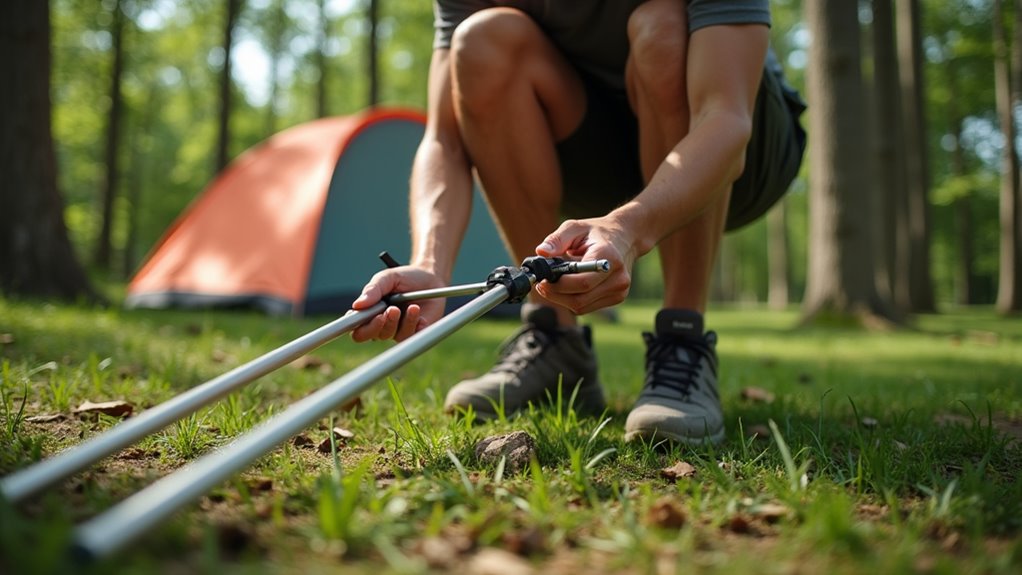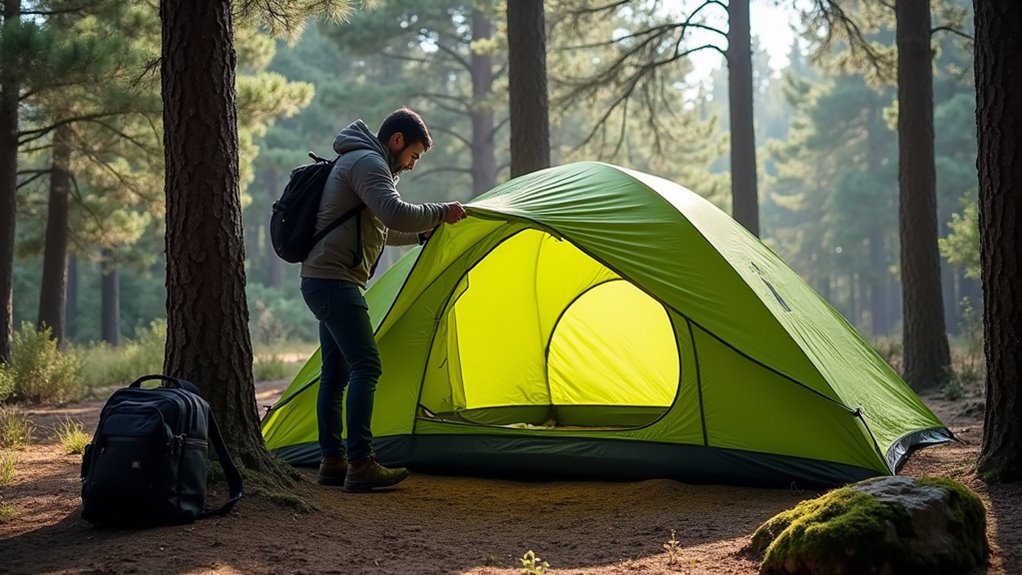How To Install Tent
This post contains affiliate links. As an Amazon Associate, we earn from qualifying purchases.
To install your tent, begin by selecting a flat, dry area and clearing it of debris. Then, lay out the tent footprint, assemble the poles, and raise the tent before staking down the corners at a 45-degree angle for stability. Further steps, including attaching the rainfly and adjusting vents for airflow, will be detailed later to help you optimize your setup for comfort and durability.
Essential Facts in 30 Seconds
- Choose a flat, dry spot away from wind and water for tent setup.
- Remove debris and sharp objects from the ground for safety.
- Assemble tent poles, raise the tent, and stake down the corners.
- Attach the rainfly fully, ensuring proper water runoff.
- Tighten guylines to keep the tent stable, especially in wind.
Selecting and Preparing the Tent Site

Picking the best tent spot makes camping safe and comfy. Find a flat, even place. It helps you sleep better and stops your tent from wearing out. Avoid rocky or bumpy ground. It can hurt you or make your tent shake.
Face the tent door away from the wind. This keeps air fresh and stops cold air from blowing in. Stay at least 200 feet away from lakes or streams. It helps keep bugs away and water clean. Trees and bushes help block strong winds. Additionally, look for natural windbreaks like trees to enhance your shelter from strong gusts.
Don’t camp in low spots that flood after rain. Check for dead branches above. They might fall and cause harm. Stay close enough to bathrooms and paths. This balance keeps you safe and private. Additionally, ensure the area is clear of potential hazards like water runoff or overhanging branches.
Follow these simple tips for a great camping trip.
Ground Preparation and Safety Considerations
Set up your tent on firm, dry soil. Check that the ground is flat to keep the tent steady. Avoid areas where water can collect, as wet ground can damage your tent and make camping uncomfortable. Additionally, be aware of wildlife activity in the area to ensure safety and prevent encounters.
Clear the space around your tent to allow easy movement and quick exit in emergencies. Plan your campsite with safety in mind. Keep paths open for fast access if needed. Taking time to prepare the ground enhances overall camping experience. These steps help ensure a safe and pleasant camping experience.
Soil Stability Assessment
Soil stability matters a lot for a safe tent setup. Check the soil type first. Loamy, sandy, or clay soils need different stakes and lengths. Understanding tent peg types can help you make the right choice.
Test soil dampness to see its strength. Too wet soil feels weak. Use tests like Standard Penetration Testing (SPT) or vane shear tests. These show soil makeup clearly.
Watch out for holes or weak spots underground. These cause instability. The soil must hold strong against wind and weather.
Remove rocks, roots, and trash. These things can make your tent unsafe. Following these steps ensures your tent stands firm and safe, especially by using sturdy metal stakes for optimal support.
Drainage and Slope Evaluation
Setting up a tent needs good drainage and slope to stay safe and steady. Pick a spot with a slight slope of 5 to 10 degrees. This slope helps water flow away from your tent. Check the land by looking for places where water runs off. Remove plants or clear small ditches to guide water away. Additionally, make sure to select a flat area that allows for proper drainage.
| Aspect | Why It Matters | What To Do |
|---|---|---|
| Gentle Slope | Moves water away | Face tent door downhill |
| Drainage Channels | Stops water from pooling | Clear leaves and grass |
| Level Ground | Keeps tent stable | Remove rocks or sticks |
Check your tent often. Avoid low spots that fill with water after rain. Additionally, consider placing a tarp under your tent for added moisture protection to ensure a dry and comfortable sleeping area. Keep your campsite dry and safe.
Emergency Access Planning
Emergency access planning saves lives at tent sites. Always have at least two clear exits. Mark exits well and keep them free of obstacles.
Space stakes or guy lines at least 10 feet apart. This space helps people move quickly and safely. Place bright exit signs and emergency lights inside large tents. These tents are usually over 1,200 square feet or hold more than 300 people. Additionally, make sure to attach the rainfly for waterproofing to help maintain visibility and protection in emergencies.
Make sure the ground is flat and steady. Remove anything people could trip on. Check drainage to avoid slippery or wet spots. Additionally, ensure that the area is clear of rocks and debris to promote safe movement during an emergency.
Safe tent sites protect everyone during emergencies.
Laying Out Tent Components
Lay out the tent footprint first. This helps match it to your chosen spot.
Place the tent body on top of the footprint. Make sure you can reach all parts easily. This makes setting up faster and smoother.
Avoid moving parts around later. This step saves time and stops frustration.
Tent Footprint Placement
Pick a tent footprint a bit smaller than your tent floor. Aim for 2 to 3 inches less on each side. This stops water from collecting under your tent.
Place the footprint flat on the ground. Check it matches the tent floor size. Smooth out all wrinkles. Wrinkles can damage the fabric over time.
Attach the footprint to the tent poles. Use grommets or tabs for a firm hold. This keeps the footprint from moving.
Good footprints use strong materials. They stop dampness and protect against tears. Right size and shape matter a lot.
A well-placed footprint keeps your tent dry and lasts longer.
Aligning Tent Body
Place the footprint firmly on the ground.
Lay the tent body flat on top. Match the tent’s shape to your sleeping and door plans. Spread the fabric evenly from the center outward. Hold each corner tight but gentle. Stake each corner with light pressure at a 45-degree angle. This lets you move them if needed.
Check that doors face the right way for easy access and wind protection. Make sure windows line up as planned. Keep the fabric smooth to avoid wrinkles and folds. Proper tension helps the tent stay strong. Confirm corners align well for easy entrance use.
Light staking helps adjust tension and shape. Now, the tent body is ready for the frame.
Assembling and Installing Tent Poles

Assembling and installing tent poles is key to a strong, safe tent. Follow these simple steps for quick setup using fiberglass or aluminum poles:
- Check Poles: Look for cracks or bends. Sort poles by size. Color codes help match poles to tent sleeves or clips.
- Connect Poles: Push smaller ends into larger ones. Align them well. Shock cords inside keep poles together and speed up assembly.
- Set Poles: Slide poles through sleeves or clip them on. Arrange poles in an “X” shape for support. Tilt poles inward slightly for better tension.
Securing the Tent Structure
Securing the tent structure keeps it strong and safe, especially in wind. Pick the right anchors for your ground. Use heavy-duty stakes for soft soil. Concrete anchors work well on hard surfaces.
Attach guy lines to the loops on the tent frame. Keep the ropes tight. Use strong, non-stretch ropes to hold steady during gusts.
Here are good anchoring methods:
| Anchor Type | Description |
|---|---|
| Heavy-duty Tent Stakes | Best for soil or sand |
| Concrete Anchors | For hard surfaces like concrete |
| Lag Bolts | Hold well in packed dirt |
| Cam-locks/Screw-in Stakes | Made for tough terrains |
| Weight-based Methods | Use sandbags or blocks for extra hold |
Check your tent often. Tighten ropes and stakes to keep the tent stable. Safety matters.
Adding Rainfly and Final Adjustments

Adding the rainfly keeps your tent dry and lets air flow well. Place the rainfly so it covers the whole tent. Make sure doors and windows can open easily.
Follow these steps for the best weather protection:
- Lay the rainfly gently over the tent poles. Avoid catching it on anything.
- Attach clips or Velcro at the corners first. Then secure the middle parts.
- Pull out guylines at an angle. This keeps the tent steady and stops flapping.
Let the rainfly hang past the tent edges. This helps water run off the sides.
Adjust vents so air can move through. Check all attachments to make sure they’re tight. Make sure the rainfly slopes away from the tent.
These steps help any rainfly work well and keep camping dry and comfy.
Frequently Asked Questions
How Do I Choose the Right Tent Size for My Group?
Pick a tent size by counting your group members first. Add two extra spots for comfort and to store gear. A tent made for six people fits a group of four well. This extra space helps everyone sleep better. It also keeps your belongings safe and dry. Choose tents with clear size labels. Look for tents that list the number of people they fit. Bigger tents weigh more but give more room. Think about where you will camp too. Tight spaces need smaller tents. Open areas allow larger tents with more headroom. Remember, a little extra space makes camping fun and easy.
Can I Set up a Tent on a Concrete Surface?
Setting up a tent on concrete is possible and common. Use special tent anchors to hold the tent firmly. These anchors can cut tent movement by half. Add heavy weights like sandbags or concrete blocks to keep the tent steady. This prevents the tent from blowing away in wind. Make sure to check the tent’s fit on the hard surface. Using a ground tarp helps protect the tent floor from scratches. This way, you enjoy camping even on tough surfaces.
What Are the Best Materials for a Tent?
Waterproof fabrics like Dyneema and nylon make great tent materials. They are very light and strong. Canvas tents last a long time and feel comfortable. These are best for car camping trips. Each material suits different needs and weather conditions. Pick what fits your trip best.
How Do I Clean and Store My Tent After Use?
Clean your tent after each use with mild soap and water. Rinse well to remove dirt and soap. Let the tent dry completely in the shade. Avoid direct sunlight to keep fabric strong. Fold the tent loosely to prevent creases. Store it in a breathable bag or cotton sack. Keep the tent in a cool, dry place to stop mold and mildew. Proper care can make your tent last many years. Regular cleaning and good storage protect your gear and save money.
What Should I Do if It Rains While Camping?
Rain can make camping tricky but manageable. Wear your raincoat and waterproof boots. Tighten your tarp so water flows away from your tent. Use a small ground tarp inside the tent for extra dryness. Keep your sleeping bag dry by placing it off the wet ground. Watch out for slippery rocks and mud near your campsite. Stay clear of low spots where water collects. Keep matches or a lighter dry in a sealed bag. Rain can cool the air, so wear warm layers to stay comfortable. A little rain doesn’t have to ruin your camping fun.
Conclusion
Remember, “a stitch in time saves nine.” Pick a flat, clear spot for your tent. Remove rocks and sticks from the ground. Spread out the tent and connect the poles carefully. Secure each corner tightly with stakes. Attach the rainfly to protect against rain. Double-check all connections and stakes. This careful setup keeps you safe and dry. Enjoy your time outdoors with a strong shelter. Happy camping!
